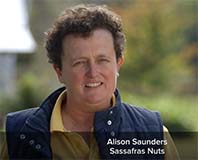Read the latest information on
Foot-and-mouth disease

Alison Saunders, a walnut and chestnut producer from Sassafras NSW, appeared in the Production Practices video, highlighting how simple it was to integrate biosecurity into her farm management routine.
It makes good business sense to reduce the risk of spreading pests and diseases by applying simple biosecurity measures as part of your everyday farm management practice and now there’s a video to show you how.
Videos are one of the tools provided by Farm Biosecurity, a joint Plant Health Australia and Animal Health Australia (AHA) project, to generate awareness about good on‐farm biosecurity practices.
Duncan Rowland, AHA’s Executive Manager Biosecurity and Product Integrity Services, said the final video in the Biosecurity Essentials series – Production Practices – provides a valuable insight into the type of activities producers can do, every day, within the structure of their daily farm management routines.
“Simple activities like making a habit of checking the condition of your stored feed when you go into the shed, recording the condition of your livestock and crops when you’re out and about or simply checking fences as you drive along, are all simple practices that can be woven into daily routines,” Mr Rowland said.
“Importantly, Production Practices gives producers a general overview about the key biosecurity activities that are inexpensive, realistic and applicable to all producers,” Mr Rowland said.
Alison Saunders, a walnut and chestnut producer from Sassafras NSW who appeared in the video, highlighted how simple it was to integrate biosecurity into her management routine.
“Our biosecurity practices are actually quite straightforward because they fit in so well with our other ongoing farming practices,” Ms Saunders said.
“A good example of this is at the end of our harvest when we need to mulch our leaves and plant material. Not only is this good for the nutrients in the soil, but it’s effective in removing potential places where diseases and pests can develop,” Ms Saunders said.
Production Practices is the final in a series of seven videos that cover the Biosecurity Essentials: Farm Inputs; People, Vehicles and Equipment; Production Practices; Feral Animals and Weeds; Farm Outputs; Train, Plan and Record. To view all the videos in the series go to farmbiosecurity.com.au/videos
The videos can also be viewed on the FarmBiosecurity YouTube channel.